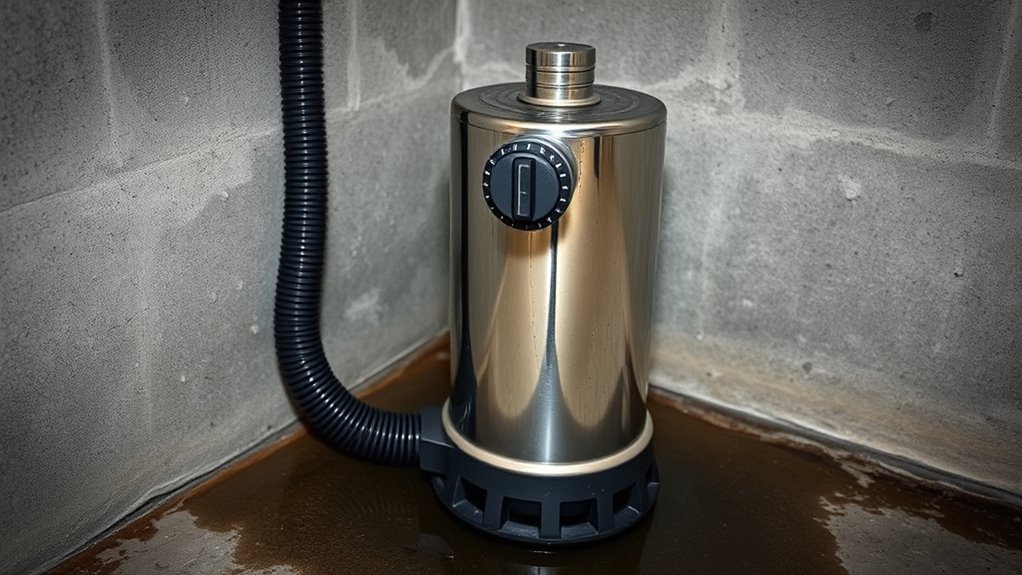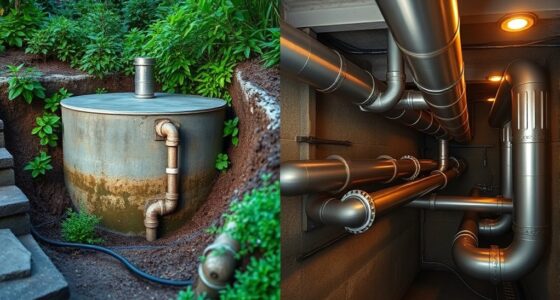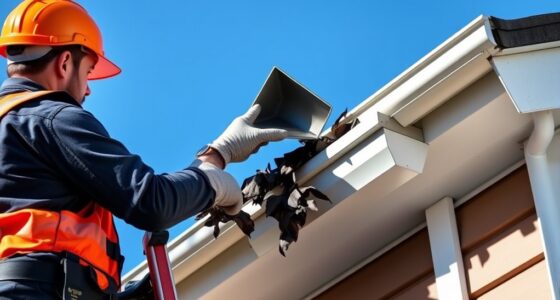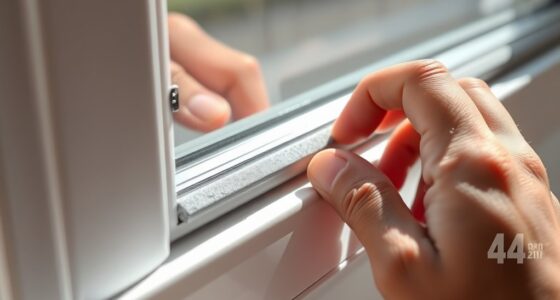To make certain your sump pump is ready before a storm, start by inspecting it for debris and checking that the float switch moves freely. Then, pour water into the basin to trigger the pump manually. Watch if it turns on and off automatically, listen for the motor, and verify proper drainage. Regularly testing your pump helps catch any issues early. Keep going to discover how to keep it functioning perfectly when you need it most.
Key Takeaways
- Regularly inspect the sump pump for debris, obstructions, and proper float movement before heavy rain.
- Test the pump manually by pouring water into the basin to ensure it activates and shuts off correctly.
- Verify the power source and outlet functionality to prevent electrical failures during storms.
- Check and clear discharge pipes to ensure efficient water flow away from the foundation.
- Conduct testing routinely to identify issues early and maintain reliable protection against flooding.
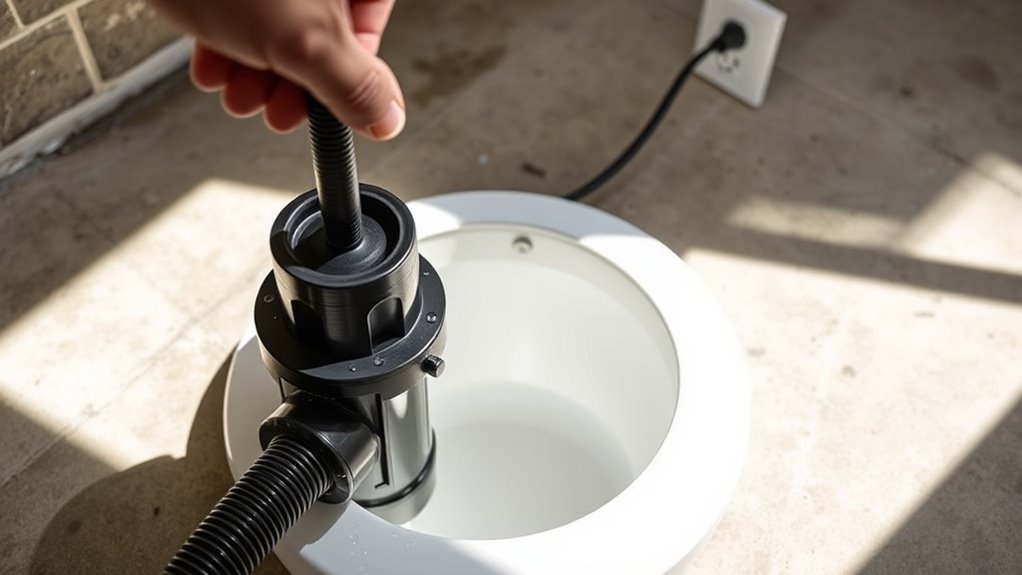
A sump pump is an essential device that helps protect your home from flooding by removing excess water from your basement or crawl space. Because it operates quietly in the background, it’s easy to forget how crucial it is until you actually need it. That’s why testing your sump pump before a storm hits is vital. You want to ensure it works properly, so you don’t find yourself scrambling when heavy rain begins pouring. Regular testing gives you peace of mind, knowing your home is safeguarded against potential water damage.
Start by inspecting your sump pump and the surrounding area. Check for any signs of debris, dirt, or obstructions that could impede its operation. Clear out any debris from the sump basin and make sure the float switch, which activates the pump, moves freely. If it’s stuck or obstructed, the pump might not turn on when needed. Confirm that the power cord is intact and securely plugged into a grounded outlet. It’s also wise to test the outlet with a different device to ensure it’s functioning properly. Electrical issues are common culprits in sump pump failures, so don’t overlook this step.
Next, you should perform a manual test. Pour water into the sump basin until the float switch activates and triggers the pump to turn on. You can do this by slowly adding water from a bucket or hose. As the water level rises, the float should rise with it, prompting the pump to start. Listen for the sound of the motor turning on and watch as the water begins to drain. Once the water level drops below the float switch, the pump should turn off automatically. If it doesn’t, or if the pump doesn’t start at all, you need to troubleshoot or replace it before the next storm.
It’s also wise to check your discharge pipe. Make sure it’s clear of any blockages and that the water can flow freely away from your foundation. If the pipe is frozen, clogged, or damaged, even a functioning pump won’t be able to do its job effectively. Consider installing or inspecting a check valve to prevent backflow, which could cause water to re-enter your basement after pumping out. Regularly testing your sump pump can help identify problems early, especially since electrical issues are common causes of failure.
Performing this simple test regularly, especially before heavy rain, ensures your sump pump is ready to work when it’s needed most. If you notice any issues during testing, address them promptly. Maintaining your sump pump now saves you from costly repairs and water damage later. Remember, a quick, thorough test can make all the difference when a storm hits, keeping your home dry and protected.
Frequently Asked Questions
How Often Should I Replace My Sump Pump?
You should consider replacing your sump pump every 7 to 10 years, depending on usage and maintenance. Regularly inspect it for signs of wear, such as strange noises or decreased performance. If it’s over a decade old, or if it frequently runs or fails tests, it’s time to upgrade. Staying proactive guarantees your system works reliably during heavy rains, preventing flooding and water damage in your basement.
Can I Install a Sump Pump Myself?
Yes, you can install a sump pump yourself if you’re comfortable with basic plumbing and electrical work. Make sure to follow the manufacturer’s instructions carefully, and plan your installation to guarantee proper drainage and power supply. However, if you’re unsure or unfamiliar with these tasks, it’s best to hire a professional. Proper installation is vital to prevent flooding and ensure your sump pump works effectively during storms.
What Is the Lifespan of a Typical Sump Pump?
Like a faithful sentinel, your sump pump typically lasts between 7 to 10 years. Regular maintenance, such as testing and cleaning, can extend its life, much like a well-maintended hero. Keep an eye out for signs of wear—struggling to activate or strange noises. When it nears its expiry date, consider replacing it to make sure your home stays dry and protected, just like a guardian always on duty.
How Do I Know if My Sump Pump Is Energy-Efficient?
You can tell if your sump pump is energy-efficient by checking its power consumption, usually listed on the label or in the manual. Look for models with an ENERGY STAR rating, as they meet energy-saving standards. Additionally, observe if it runs efficiently without frequent cycling or overheating. Upgrading to a newer, ENERGY STAR-certified sump pump can save you electricity and reduce your utility bills over time.
Are Backup Sump Pumps Necessary for My Home?
Absolutely, backup sump pumps are essential for your home! Imagine a storm so fierce it floods your basement, and your primary pump suddenly fails—disaster! A backup guarantees you’re protected from those worst-case scenarios, giving you peace of mind. It’s like having a superhero on standby, ready to save your home from water damage when you need it most. Don’t wait for a flood—install a backup today!
Conclusion
Think of your sump pump as a vigilant guardian, quietly standing watch beneath your home. When storms threaten, it springs into action, like a loyal sentinel protecting your sanctuary. Testing it beforehand guarantees this guardian is ready to face the tempest, keeping your home dry and safe. Don’t wait for the flood to reveal its weakness—show your home you care by giving your sump pump the attention it deserves. A well-prepared pump is your shield when storms roll in.
